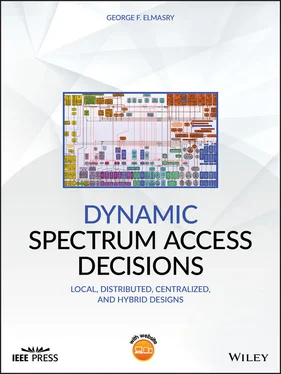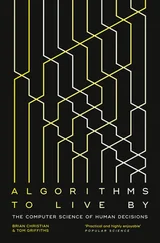In Equation (6.5), notice the following:
pk, n is the transmit power of the kth transmit/receive pair over the resource block n.
αk, n, φk, n, and ωk, j, n are positive parameters that depend on the desired systems parameters and propagation model.
The summation in the denominator is to consider orthogonal signal impact where ωk, j, n depends on the impact of the other users' channels on the resource block n.
αk, n represents the impact of the kth pair on the signal dimension of the nth block, φk, n.
Notice that for the special case of perfect orthogonality (where a signal in one dimension has no interference impact on signals in other dimensions), the summation in the denominator becomes zero and φ k, nbecomes zero except for the k th dimension, making Equation (6.5) render a simple signal to noise ratio. The 5G DSM model used here considers imperfect channel orthogonality. 21
A comprehensive 5G DSM has to face many other challenges, including the following:
1 Power control has to lead to energy emission optimization in different scenarios, including when spectrum assignment decisions are made through a centralized arbitrator (i.e., the macrocell acting as main fusion center, as in Section 6.4.1) and when spectrum assignment decisions are made autonomously by cell access points, as in Section 6.4.2.
2 When spectrum assignment decisions are made by a centralized arbitrator, the 5G DSM technique should optimize energy emission globally. A metric for global energy efficiency, EEG, can be used to gauge the efficiency of the decisions reached.
3 The optimization techniques used can be heuristic and may not render the best optimum way all the time. The DSM technique has to consider the tradeoff between accuracy, computational power, and speed of making decisions using heuristic algorithms. Techniques such as fractional programming and heuristic attempts to create sequential convex optimization in large‐scale dense deployments can become challenging. 22
4 When spectrum assignment decisions are made autonomously by a cell access point, the end‐user device can act in a noncooperative manner (consider the case in Figure 6.14). The end‐user device can be aiming to maximize its own energy efficiency and obtain a certain rate of transmission at the lowest power consumption regardless of the impact of its own arbitration decision on the global optimization of energy emission.
5 Resource blocks are employed for transmit/receive pairs dynamically and are continually assigned and freed, meaning the optimization problem is always trying to reach equilibrium.
6 There is a tradeoff between global performance in the centralized case and fairness. In an equilibrium problem settings, fairness has to be less subjective and be about not starving one end user of spectrum resources on the expense of another end user.
Now let us consider a wireless network with K transmit/receive pairs and N available resource blocks where SIR can be represented by Equation (6.5). Let us assume that for any given user K , energy efficiency can be measured in bit/Joule or the ratio of the achieved transmission rate (from the obtained resource block) to the dissipated power by the device. This device energy efficiency can be expressed as:
(6.6) 
Equation (6.6)can be synthesized as follows:
pc. k is the power dissipated by the transmitter for the kth transmit/receive pair.
PK is the power allocation vector over the utilized N resource blocks, which is one of many possible vectors that can be allocated as denoted by in the equation:(6.7)
The end‐user device has local power constraints , which is the maximum power the device can dissipate. Thus:(6.8)
In order to create fairness as explained above, we must assure that the end‐user device will have a minimum transmission rate. However, this minimum transmission rate can be illusive if we want to also limit the minimum number of spectrum resources blocks we can assign to an end user. This will require creating a metric that measures the maximum rate that can be achieved for the minimum number of spectrum resource blocks. The term SIRk, nrepresents the maximum SIR we can expect when interference and noise are minimal.
The end‐user device can be assigned a target data transmission rate in order to achieve fairness. We have to consider that target data rate in terms of SIRk, n. This means the nominator in Equation (6.6) has some boundary data rate. The data rate the end‐user device can achieve, θk, is bounded as:(6.9)
The goal of the DSM technique is to allocate to each end user a power vector as in Equation (6.7), where the power dissemination of the end‐user device is bounded by Equation (6.8) and the data rate transmission is bounded by Equation (6.9). Globally, the DSM technique generates a feasible 23set of power for all the transmitting nodes and all the resource blocks. The available combination of the global sets can be expressed as:
(6.10) 
The DSM technique generates the feasible set from Equation (6.10), which can be expressed as:
(6.11) 
The selection of the feasible set considers many factors, as explained earlier, including minimizing SIR, maximizing date rate, minimizing power dissemination, and using sensing information to avoid interference with other systems.
Now let us look at a global metric a centralized DSM arbitrator may consider to achieve this multifaceted global energy efficiency, EE Gwhich can be expressed as:
(6.12) 
Notice that in Equation (6.12)the nominator is the global data rate while the denominator is the summation of assigned power. The search for an assigned power set to all transmit/receive pairs can be weighed based on maximizing this global metric (among other metrics). Notice that EE Gdoes not consider the device circuits' efficiency. The device circuits' efficiency is the ratio of dissipated power as spectrum emission to the assigned power vector. Also this optimization does not consider the presence of AWGN.
EE Gis one of many metrics the centralized arbitrator can use. Note that the more metrics one attempts to include in a spectrum fusion technique, the more complicated the technique can become. One has to look for the most effective modeling of the problem at hand and consider the most critical metrics that can help with the development of a practical cognitive spectrum fusion technique that can be evaluated in real time and their post processing can bring about meaningful policy and configuration parameters changes.
6.6 The Role of the Cell and End‐User Devices in 5G DSM
The optimization problem described in the previous section may require the collection of information from the end‐user device in order to ascertain if the central arbitrator resource blocks and power needs to be adjusted. Recall that Equation (6.12) did not consider the presence of AWGN or the relationship between allocated power and dissipated spectrum, which requires getting some performance metrics from the end‐user device to adjust the allocation of resource blocks and power. The end‐user device's lower protocol stack layer can collect different measurements such as block error rate, latency, jitter, and channel quality. This data can be utilized by the upper protocol stack layer algorithms for real‐time adaptation of traffic load pushed to the lower stack layers and can also be abstracted and forwarded to the centralized arbitrator to fine‐tune the global resource allocation modules.
Читать дальше
















